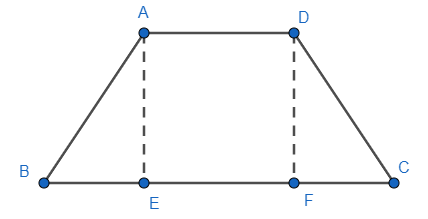
If ABCD is an isosceles trapezium, then
(A).
(B).
(C).
(D).
Answer
518.7k+ views
1 likes
Hint: Start by drawing the diagram with all required constructions. Use the property that in isosceles trapezium the lengths of the non-parallel sides are equal.
Complete step-by-step solution -
Let us start with the solution by drawing a diagram of the situation given in the figure along with the required constructions for better visualisation.

In the above figure, we have constructed lines AE and DF such that they are perpendicular to both AD and BC.
Now, as it is given that ABCD is an isosceles trapezium, the lengths of the non-parallel sides must be equal, i.e., AB=DC.
Now, if we focus on
AB=DC
We also know that AE=DF, as the perpendicular distance between two parallel lines are equal at any point on the lines. And
Therefore, using the RHS rule of congruency, we can say that
So, using the rule of CPCT, we can deduce that:
Therefore, the answer to the above question is option (a).
Note: Some, other important properties of the isosceles trapezium are:
The diagonal of isosceles trapezium bisect each other and the sum of opposite angles is equal to
Complete step-by-step solution -
Let us start with the solution by drawing a diagram of the situation given in the figure along with the required constructions for better visualisation.

In the above figure, we have constructed lines AE and DF such that they are perpendicular to both AD and BC.
Now, as it is given that ABCD is an isosceles trapezium, the lengths of the non-parallel sides must be equal, i.e., AB=DC.
Now, if we focus on
AB=DC
We also know that AE=DF, as the perpendicular distance between two parallel lines are equal at any point on the lines. And
Therefore, using the RHS rule of congruency, we can say that
So, using the rule of CPCT, we can deduce that:
Therefore, the answer to the above question is option (a).
Note: Some, other important properties of the isosceles trapezium are:
The diagonal of isosceles trapezium bisect each other and the sum of opposite angles is equal to
Latest Vedantu courses for you
Grade 11 Science PCM | CBSE | SCHOOL | English
CBSE (2025-26)
School Full course for CBSE students
₹41,848 per year
Recently Updated Pages
Master Class 9 General Knowledge: Engaging Questions & Answers for Success

Master Class 9 English: Engaging Questions & Answers for Success

Master Class 9 Science: Engaging Questions & Answers for Success

Master Class 9 Social Science: Engaging Questions & Answers for Success

Master Class 9 Maths: Engaging Questions & Answers for Success

Class 9 Question and Answer - Your Ultimate Solutions Guide

Trending doubts
Where did Netaji set up the INA headquarters A Yangon class 10 social studies CBSE

A boat goes 24 km upstream and 28 km downstream in class 10 maths CBSE

Why is there a time difference of about 5 hours between class 10 social science CBSE

The British separated Burma Myanmar from India in 1935 class 10 social science CBSE

The Equation xxx + 2 is Satisfied when x is Equal to Class 10 Maths

What are the public facilities provided by the government? Also explain each facility




